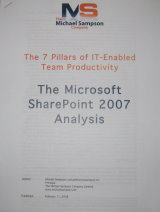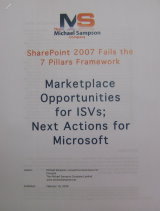In early February, my colleague and industry analyst, Michael Sampson, sent me copies of his two most recent independent research papers that evaluate SharePoint 2007 as a team collaboration tool.

Microsoft SharePoint 2007 Analysis
SharePoint fails the 7 Pillars Framework: Marketplace Opportunities for ISVs; Next actions for Microsoft
I've known Michael Sampson for the past 11 years, as a professional (we met as speakers at an Electronic Messaging Association EMA Conference). In that time, we have become good friends and, even though we differ in our choice of computing platforms, I still have great respect for his work as an independent researcher and analyst. Michael funds his own research and enjoys the freedom to publish his observations and recommendations without having to water them down due to vendor pressure. I think he's a balanced researcher and an excellent communicator.
In 2005 -- before Microsoft began promoting SharePoint as the ultimate collaboration tool -- Michael developed and published his 7 Pillars framework as a way to evaluate and filter the claims of collaboration vendors against the capabilities of their products. His framework proposes and defines 7 pillars of collaboration:
- Pillar 1 - Shared Access to Team Data
- Pillar 2 - Location Independence
- Pillar 3 - Real-time Joint Viewing
- Pillar 4 - Team-Aware Calendaring
- Pillar 5 - Social Engagement
- Pillar 6 - Team Task Management
- Pillar 7 - Collaboration Auto-Discovery
I've had the opportunity to not only read Michael's 7-Pillars paper but to sit in on his 7-Pillars for IT Professionals workshop. Both are excellent. (You may download the 7 Pillars paper for free, here.)
How does SharePoint measure up as a 7-Pillars team collaboration tool?
There's no doubt that Microsoft SharePoint is taking the world by storm. Microsoft claims incredible sales revenue from SharePoint, but does that mean SharePoint is a great collaboration tool? To evaluate that, Michael evaluates SharePoint against the 7 Pillars above and, guess what? SharePoint doesn't do so well...
 From the executive summary:
From the executive summary: "On its own merits, SharePoint fails the needs of teams for collaborative software in 6 out of the 7 areas. It thus passes only one of the areas on its own merits, and it passes an additional two areas if the organization adds additional server software from Microsoft. However, using the software available from Microsoft, it earns a failing grade in 4 out of the 7 areas."
Ouch! One can hardly expect that any SharePoint ISV will agree with Michael's collaboration report card, as to do so would undermine their credibility. Microsoft says the success of SharePoint, which has become a billion dollar business, speaks for itself.
But does that success mean that SharePoint is a good tool for collaboration? I think Michael nails it with his 7-Pillars collaboration report card. Michael has freedom to do objective analysis and to call it like he sees it; he holds no punches in the paper, praising Microsoft for the things they got right and challenging them to improve in areas where they fail to make a passing grade. As an academic, he provides ample information to support his evaluations and conclusion.
The paper is not an attempt to beat up SharePoint, its an attempt to open our eyes to what a truly successful and usable collaboration product looks like and to help us make informed evaluations of these tools. Michael's encouraging us to expect more from collaboration products and to hold collaboration vendors accountable for their claims. I think it's easy for vendors to make claims when there's no measurement tool. Well, with the 7 Pillars framework, love them or hate them, there's a proven framework that can be used to evaluate the effectiveness of collaboration tools. How well would your collaboration tool of choice stack up against the 7 Pillars model?
The paper, intended for CIOs, IT Business Analysts and IT Organizations charged with evaluating the efficacy of SharePoint for team collaboration, provides a report card and a summary of recommendations for organizations that are currently or considering a SharePoint deployment. It's not an attempt to talk someone into our out of using SharePoint, just to approach the deployment with caution and reasonable expectations -- as we should do with any technology. The paper is 31-pages in length, and you can download and review the Summary Document which contains the first 7 pages of the report and a summary page (Registration Required). For any IT professional, I think the full paper is a must read, whether they use SharePoint or not. It would take you years to compile the experience that Michael's poured into 30+ pages of the report. If you are involved in collaboration, you owe it to yourself to buy a copy, or at least read the free summary.
SharePoint shortcomings represent significant opportunities for Consultants and ISVs as well as for Microsoft.
 In the course of his research for this first paper, Michael collected a lot of information. As we discussed what he was finding and the surprising results, it became clear that each shortcoming represented a considerable opportunity for an enterprising consultant/ISV and even for Microsoft itself. These, Michael packaged into an even more detailed paper: SharePoint fails the 7 Pillars Framework: Marketplace Opportunities for ISVs; Next actions for Microsoft. For each Pillar, Michael outlines the problems with the current shipping product and then offers several recommendations to Microsoft as well as pointing out specific business opportunities for SharePoint ISVs.
In the course of his research for this first paper, Michael collected a lot of information. As we discussed what he was finding and the surprising results, it became clear that each shortcoming represented a considerable opportunity for an enterprising consultant/ISV and even for Microsoft itself. These, Michael packaged into an even more detailed paper: SharePoint fails the 7 Pillars Framework: Marketplace Opportunities for ISVs; Next actions for Microsoft. For each Pillar, Michael outlines the problems with the current shipping product and then offers several recommendations to Microsoft as well as pointing out specific business opportunities for SharePoint ISVs.
Conclusion:
Although I am not a SharePoint user myself, I learned a lot from reading these papers -- both about SharePoint and about how to look differently at collaboration tools in general. I find the 7-Pillars of collaboration model helpful in evaluating and positioning collaboration tools. Michael's paper encourages us to look at what the collaboration products actually DO instead of what their vendors claim they can do. I highly recommend these papers and, if you are an organization that uses or is considering deploying SharePoint or any collaboration tool, I strongly recommend Michael's services to help you make your collaboration deployment a success.
What would I like to see?
I would like to see Michael do a similar research paper on Lotus Notes and on some of the popular Web 2.0 collaboration tools. We've talked about this and I've encouraged Michael to do a similar research paper on Lotus Notes. I can already see several areas where Lotus Notes would do well, and several were it would not do so well according to the 7-Pillars Framework. Michael tells me that he hopes to do a Lotus Notes paper in the future. I know that it takes a lot of time and money to do the research and write these reports, but if he does I'm sure that, too, will be equally valuable and well worth the investment.
Disclaimer: Michael allowed me the opportunity to review these papers as works in progress and provided me with finished copies of each. I did not pay for the final copies I was given, although I would -- they are that good. I ultimately decided not to blog about the content of the papers as much as the process Michael used to evaluate SharePoint as a tool for team collaboration. I hope that you will learn from both and I encourage you to read on and reach your own conclusion.







Discussion/Comments (4):
Great post on SharePoint and team/project collaboration...some day Microsoft will capitalize on their incredible monopoly on individual productivity tools and SharePoint will be the tool where most team's get their work done. Or Google, Zoho, and others will beat them to it and MS Office and SharePoint die slow and painful deaths. In the meantime, there are still great options out there that do a much better job (IMO, but I'm biased) of facilitating team collaboration than SharePoint. Here's a good article about how ProjectSpaces compares to SP: { Link }
Konstantin (): 2/18/2009 11:45:12 AM
One more tool that made in our company training collaboration less painfull is <a href="{ Link } management system </a> for SharePoint.
So right now we are doing document cerculation and corporate training from one place - SharePoint...
Samuel Cohen (http://chanasys.com): 9/5/2009 3:01:33 PM
I know some Organization Portals that are very difficult to browse as they are based on SharePoint and seem to need Internet Explorer from MS.
Compare { Link } based on Oracle to
Tel Aviv Municipality based on SharePoint
{ Link }
Discussion for this entry is now closed.